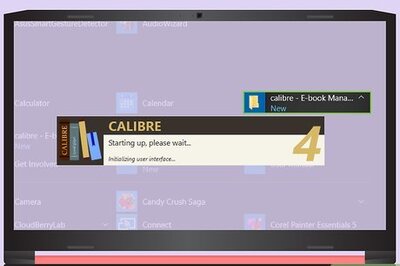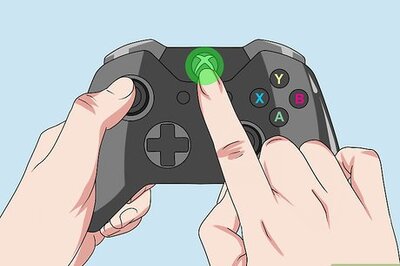
views
How to Tell if Shoes Are Too Big
There’s excess room at your toe or heel. While your feet shouldn’t touch the front and back of your shoe, there shouldn’t be a large gap of space, either. In general, there should be about a finger’s width of space (3/8 to 1/2 an inch) between your longest toe and the front of the shoe, and you should be able to slide one finger snugly between your heel and the back of the shoe. More space than this indicates that your shoes are too big.
Your feet slide around when you walk. If your shoes are too big, your feet may slip back and forth when you walk or run. If your feet slide from side to side, your shoes are too wide. This excess movement may make you feel unstable when you walk and can sometimes cause blisters.
Your heel lifts or pops out when you walk. Properly fitting shoes should be snug and secure, so if your heel constantly comes out of your shoe when you walk, it means your shoes are too big and aren’t doing their job. This is especially true if you’ve already tightened your laces or straps as tightly as possible.
Your shoes are too loose even when the laces are tightened. If you constantly find yourself tightening your laces because your shoes feel too loose or uncomfortable, it’s likely a sign they’re too big or too wide. Your shoes should fit snugly without you having to pull the laces or straps extra tight.
How to Find the Perfect Fit
Have your feet measured. Because different brands and styles of shoes fit differently, one of the best ways to find the proper fit is to have your feet measured. Go to a shoe store to have this done professionally, or do it yourself by tracing your feet on a piece of paper and measuring the length and width. Compare these measurements to a shoe fit guide to find your proper size. Even if you measure your feet, it’s still a good idea to try shoes on to make sure they’re comfortable.
Choose your size based on your larger foot. Most people have one foot that is slightly larger than the other, so make sure you try the shoes on both feet. Pick a size that fits your larger foot best, but make sure it’s still comfortable for your smaller foot, as well.
Wear socks when trying on shoes. If you’re shopping for shoes that you’d normally wear socks with (like sneakers), be sure to bring a pair with you when you try the shoes on. Socks take up a bit more space than your feet alone, so it’s important to make sure the shoes still fit comfortably with an added layer. This isn’t necessary if you’re shopping for shoes you don’t wear socks with, like flip flops or sandals.
Walk around when trying on shoes to see if they’re comfortable. Just because a shoe seems to fit well when you’re sitting doesn’t mean it will be comfortable to wear all day. When shopping for shoes, get up and walk around to see how they truly fit. Make sure they don’t rub and that your feet don’t slide around in them.
Shop for shoes in the afternoon or evening. Your feet swell throughout the day, especially if you stand for long periods of time. Because of this, it’s best to shop for shoes at the end of the day, when your feet are at their largest. This helps ensure that your shoes will fit comfortably all day.
Choose shoes with a finger’s width of space at the front and back. In general, shoes that fit properly leave a finger’s width (about 3/8 to 1/2 inch) of space between your toes and the front of the shoe and your heel and the back of the shoe. The shoes should feel comfortable when you walk around, with no rubbing or chafing, and they should be snug and supportive.
How to Tell if Shoes Are Too Small
Shoes that are too small will feel uncomfortably tight. If your shoes are too tight, you likely won’t have any wiggle room. Your toes may touch the front of the shoe, and you may get blisters on the back of your heel from where it rubs against the shoe. Wearing too-tight shoes can also cause pain, irritation, and tingling, as well as calluses, corns, and ingrown toenails. If your shoes are too narrow, your toes will feel crammed together and may even overlap.
Is it better for shoes to be tight or loose?
It’s better for shoes to be loose than too tight. Ideally, your shoes should fit snugly and securely, but if you must choose between shoes that are slightly too tight or slightly too loose, it’s generally better to choose the ones that are loose. Wearing shoes that are too tight can cause blisters, pain, and even health conditions like bunions and hammer toe. Having a bit of wiggle room is better for your circulation and overall foot health. When wearing shoes that are too big, consider wearing thicker socks, stuffing the toes, or using insoles to reduce some of that excess space.
Determining if Specific Types of Shoes Are Too Big
Running shoes are too big if your feet feel unstable when running. Running shoes are meant to provide support and security when you run, so feeling unstable or a lack of control is often a sign your shoes are too big. This lack of stability is caused by the excess movement of your feet within the shoe, which can also sometimes lead to blisters on your heel or the ball of your foot. Another sign your shoes are too big is your heel slipping or lifting up when you walk, even if the laces are tied tightly.
Dress shoes are too big if your feet slide around when you walk. While dress shoes fit differently depending on the brand and the style, in general, they should fit snugly. This means if your feet slide around or your heel slips out when you walk, the shoes are likely too big. Additionally, there should be no more than about a finger’s width of space between your toes and the front of the shoe.
Boots are too big if your heel lifts when you walk. Boots should fit snugly, so some common signs that your boots are too big include your heel lifting as you walk, your toes sliding around in the front, and the boots feeling loose or baggy around your ankle. These all indicate a lack of proper support.
Crocs are too big if your heel slips out easily when the strap is fastened. When you walk in Crocs, your heel should stay firmly in place; it shouldn’t slip out the back of the shoe. Your foot should fit snugly within the shoe with minimal movement. If you can easily slide it back and forth in the shoe, your Crocs are probably too big. As with other types of shoes, your Crocs are also likely too big if there’s a large amount of space at the toe of your shoe. Note that the Crocs brand has different fit styles. The roomy fit offers more space in the width, depth, and length of your shoes, so your feet likely won’t meet the sides. The relaxed fit offers a bit more room around the perimeter of your foot than the standard fit, and the standard fit is the most snug and secure style.
Birks are too big if there is too much space at the heel and toe. When your Birkenstocks fit properly, your toes should almost reach the edge of the footbed, without jutting over or having more than a quarter inch of space between your toes and the edge. Your foot should not slide around as you walk, and if you’re constantly having to tighten the straps, it’s a strong indication your Birkenstocks are too big.
Chacos are too big if the straps feel loose, even when tightened. Chaco sandals come with straps to adjust the fit and security of your shoe. If you have your straps tightened fully and they still feel too loose, it’s a good sign your Chacos are too big. Additionally, for a proper fit, your heel should feel cupped and not slide around when you walk, and there should be no more than 0.4 inches of space between your toes and the front of the shoe.
Shoe Fit FAQs
How often should you measure your feet? Aim to measure your feet about once a year. Feet can grow and change overtime due to factors like aging, weight changes, and pregnancy. Measuring regularly helps ensure that you’ll be able to choose the best shoe size for your feet.
Can you stretch shoes that are too small? It is technically possible to stretch shoes made of materials like leather, but it isn’t a good idea to buy too-tight shoes expecting to stretch them. Some shoes may not stretch that much, and overstretching can damage the shoe. Purchase shoes that fit properly whenever possible. For minor adjustments, however, use a shoe stretcher or opt for professional stretching services.
Can you shrink shoes that are too big? Depending on the shoe’s material, it may be possible to shrink them. To shrink leather, suede, or canvas shoes, dab some water on the ill-fitting area until it’s damp. Then, blow dry the area on a medium setting. Try on the shoes to see if the material shrunk. If you cannot shrink your shoes, it’s still possible to make them fit better by wearing thicker socks, using heel or ball of foot cushions, or adding an extra insole.
What happens if you wear shoes that are too big or too small? Wearing shoes that are too small leads to pain and discomfort and can sometimes cause medical conditions like ingrown toenails, bunions, hammer toe, and other foot deformities. Wearing shoes that are too big may cause blisters, an increased risk of tripping and injury, poor posture, and an increased strain on your ankles and feet due to lack of support.
How can you tell if a child’s shoes fit properly? Kids may not be the best judge of whether or not their shoes fit properly, so it’s usually best to check for yourself. Make sure that there’s about a finger’s width of space between their toes and the front of the shoe, and stick your finger in between their heel and the back of the shoe to make sure it’s not too tight or loose. Ask your child if they’re able to wiggle their toes while wearing the shoes, as well. Some people are tempted to buy shoes that are slightly too large so the child can grow into them, but this isn’t necessarily the best idea. Shoes that are too big do not provide the support your child’s feet need.

















Comments
0 comment